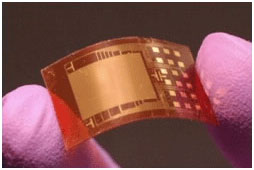Professor Zhong Lin Wang from the Georgia Institute of Technology has created a nanogenerator utilizing zinc oxide piezoelectric nanowires that generate an electric current when subjected to mechanical stress.
The piezoelectric effect occurs only in non conductive materials such as crystals and ceramics. The most well known being quartz as used in quartz clocks. Other crystals are tourmaline, topaz, Rochelle salt and cane sugar. This effect was discovered in 1880 by the Jacques and Pierre Curie brothers.
The flexible chip designed by Professor Wang has millions of tiny nanowires measuring from 1/5,000th to 1/25th the diameter of a human hair and are capable of creating energy from low frequency vibrations and movements such as the wind. An applied mechanical stress upon Wang’s flexible nanogenerator such as flexing or pressure will generate a voltage. This means that the simple act of walking, running or even heavy breathing could be sufficient to create the energy needed. Further applications could be developed to fit on or in the body to utilize the movement and sound of the patient’s heartbeat and provide power to assist the operation of the patient’s heart.
Further developments will enable the movement of blood through the body to generate sufficient energy to power items such as iPods, mobile phones and other portable electronics. The nanogenerator is cable of providing power to a liquid crystal display or a LED light and will, according to Professor Wang, will generate enough voltage provided by two AA batteries, when five nanogenerators are stacked together.
